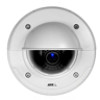Axis Communications P3367-VE P3367-VE - User Manual - Page 22
Exposure Settings
 |
View all Axis Communications P3367-VE manuals
Add to My Manuals
Save this manual to your list of manuals |
Page 22 highlights
AXIS P3367-VE Fixed Dome Network Camera Video and Audio Exposure Settings Configure the exposure settings to suit the image quality requirements in relation to lighting, frame rate and bandwidth considerations. Exposure control - This setting is used to adapt to the amount of light used. Automatic is the default setting and can be used in most situations. The shutter speed is automatically set to produce optimum image quality. Flicker-free 50 or 60 Hz is used to remove flicker which can be caused by fluorescent and other light sources. The Hold current option locks the current exposure settings. Enable Backlight compensation - Enable this option if a bright spot of light, for example a light bulb, causes other areas in the image to appear too dark. Exposure zones - This setting determines which part of the image is used to calculate the exposure. For most situations, the Auto setting can be used. For particular requirements, select a predefined area. Shutter & Gain The shutter and gain settings affect the amount of motion blur and noise in the image. To adapt to different lighting, available storage space and bandwidth, it is often necessary to prioritize either low motion blur or low noise. The Axis product allows using different prioritization in normal light and in low light. Shutter speed is related to the amount of time the shutter is opened and is measured in seconds (s). A slow shutter speed allows more light to reach the sensor and can help produce a brighter image in low light situations. On the other hand, a slow shutter speed can cause moving objects to appear blurry. Set Shutter to • Auto to set the shutter speed automatically. If required, use Max shutter to limit the shutter speed to prevent the frame rate from being reduced. For example, to get 30 fps, set Max shutter to 1/30. • Fixed to use a fixed shutter speed. Gain, measured in decibel (dB), is the amount of amplification applied to the image. A high gain may provide a better image in low light situations but will increase the amount of image noise. Set Gain to • Auto to set the gain automatically. If required, use Max gain to limit the applied gain. • Fixed to use a fixed gain. When Shutter and Gain are both set to Auto, it is possible to set the Priority between low motion blur and low noise manually and to use a different Priority in Normal Light and in Low Light. Example Consider an area where people or vehicles move during the day, but where there should be no movements during night. To be able to, for example, recognize faces or license plates, move the normal light priority slider toward low motion blur. At nighttime, motion detection is more important than identification. Motion blur is acceptable and since low light can cause a lot of noise, move the low light priority slider toward low noise. Example If storage space or bandwidth is limited, try using a lower gain. This will reduce image noise and produce smaller image files. Iris adjustment Select Enable automatic iris adjustment to automatically compensate for changing light conditions. This option is not available if a fixed iris is used. Use the Iris adjustment slider to set the preferred F-value. The scale represents the amount the iris is open. If set to 0, the iris is opened as much as possible. If set to 100, the iris is closed as much as possible. The actual F-value is shown below the slider. If automatic iris adjustment is enabled, the iris will stay at this position as long as light conditions are favorable. If light conditions change, the iris will adjust itself to the best iris settings. If automatic iris adjustment is disabled, the iris will lock on the set position regardless of light conditions 22















